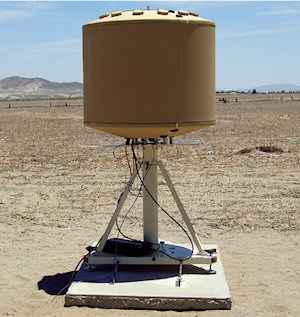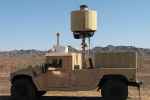LSTAR®
Description of the radar set, tactical-technical characteristics

Figure 1: Portable version of LSTAR with rigid radome

Figure 1: Portable version of LSTAR with rigid radome
| Specifications | |
|---|---|
| frequency: | L-Band |
| pulse repetition time (PRT): | |
| pulse repetition frequency (PRF): | |
| pulsewidth (τ): | |
| receive time: | |
| dead time: | |
| peak power: | |
| average power: | |
| instrumented range: | |
| range resolution: | |
| accuracy: | |
| beamwidth: | |
| hits per scan: | |
| antenna rotation: | |
| MTBCF: | |
| MTTR: | |
LSTAR®
LSTAR® (Lightweight Search and Track Acquisition Radar) is an L-Band low-cost, tactical radar designed to fill critical gaps in air surveillance to protect borders, vital infrastructure and other high-value assets. The LSTAR® family of air surveillance radars provides 360 degree, 3-D electronic scanning capabilities for detecting and tracking the most difficult airborne targets. LSTAR® is adapted for detection and tracking of small low-flying unmanned aerial vehicles (UAVs, often referred to by the media as drones). The radar detect and track also fixed-wing aircrafts and helicopters such as ultralights, para-gliders, and hang-gliders. Is is usable for border air surveillance, UAV sense and avoid, local airspace management, critical infrastructure protection, and wind farm applications.
The LSTAR (V)2 is for applications with minimum infrastructure available, while the larger LSTAR (V)3 is for applications that require better performance where and slightly more infrastructure is available. LSTAR systems are network ready using standard ASTERIX, DDS, or custom interfaces; can be used to cue thermal imaging cameras; offer full remote and unattended operation; and are transportable for rapid and unobtrusive emplacement. The radar systems provide low maintenance and lifecycle costs.
More information:



